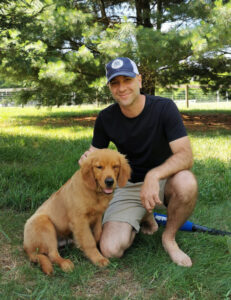When Do Golden Retrievers Stop Growing? Growth Stages, Key Milestones

Explore the growth stages of Golden Retrievers in our focused guide. Learn how these beloved dogs develop from energetic puppies to full-grown adults, and what factors influence their growth. Essential for Golden Retriever owners, this post offers key insights for nurturing a healthy, well-developed companion. Let’s dive in!
Growth Phases of Golden Retrievers
Golden Retrievers, known for their friendly and loyal nature, go through several distinct growth phases from puppyhood to adulthood. Understanding these phases can help owners provide the right care at each stage.
Puppyhood and Rapid Growth
Puppyhood is the first and one of the most crucial phases in a Golden Retriever’s life. This phase, spanning from birth to around six months, is marked by rapid physical growth.
- Birth to 3 Months: Golden Retriever puppies grow quickly in size and weight. During this period, they develop motor skills and begin to explore their surroundings. Proper nutrition is crucial at this stage to support their rapid development.
- 3 to 6 Months: This is a period of continued rapid growth. Puppies will start to look more like miniature versions of their adult selves. Their rate of growth during these months is astonishing, and it’s not uncommon for them to gain weight quickly.
Throughout puppyhood, it’s important for Golden Retrievers to have a balanced diet rich in nutrients that cater to their developmental needs. Regular vet check-ups are essential to monitor their growth and overall health.
Transitioning to Adulthood
Adolescence and Early Adulthood are the next stages in a Golden Retriever’s growth.
- 6 to 12 Months: During this period, growth starts to slow down. Golden Retrievers will continue to fill out in width and muscle, rather than just growing taller. This is also the time when they reach sexual maturity.
- 12 to 18 Months: By this age, most Golden Retrievers will have reached their full height. However, they may continue to fill out and gain muscle tone. It’s important to continue with good nutrition and regular exercise to ensure healthy development.
- 18 to 24 Months: At this stage, a Golden Retriever is considered to be transitioning fully into adulthood. While most of their physical growth is complete, they may continue to develop in terms of muscle and coat condition.
Golden Retrievers generally reach their full height by one year of age but may continue to fill out and mature in muscle tone and size until they are about two years old. Regular exercise, consistent training, and a balanced diet are key to ensuring a healthy transition from puppyhood to a robust, adult Golden Retriever.
Factors Influencing Growth in Golden Retrievers
The growth rate and eventual size of Golden Retrievers can be influenced by various factors. Understanding these can help owners ensure their pets grow healthily and reach their full potential.
Genetics and Breed Standards
Genetics play a pivotal role in determining the size and growth rate of Golden Retrievers. The genetic makeup inherited from their parents significantly influences their physical characteristics.
- Breed Lines: Different lines of Golden Retrievers (such as show lines vs. field lines) can have varying growth rates and adult sizes. Show lines tend to be stockier and may grow at a slower pace, while field lines are often leaner and more agile.
- Size of Parents: Generally, the size of a Golden Retriever’s parents is a good indicator of their own adult size. Puppies from larger parents tend to grow larger, while those from smaller parents may remain comparatively petite.
Understanding the breed standards can also provide insights into expected growth. The American Kennel Club (AKC), for instance, outlines standard sizes for Golden Retrievers, which can serve as a reference for expected growth patterns.
Nutrition and Health
Nutrition and overall health are crucial in influencing a Golden Retriever’s growth.
- Balanced Diet: A diet that is well-balanced and tailored to the growth needs of Golden Retrievers is essential. Puppies require more protein and specific nutrients to support their rapid development, while adults need a diet that maintains their health and body condition.
- Health Conditions: Certain health conditions can impact growth. For instance, issues like parasitic infections, hormonal imbalances, or digestive problems can hinder proper growth and development.
- Exercise: Adequate exercise is important for muscle development and overall health but should be balanced with rest, especially during the rapid growth phases to avoid stress on developing bones and joints.
Recognizing a Fully Grown Golden Retriever
Knowing when a Golden Retriever has reached full maturity is important for understanding their developmental stage and adjusting their care accordingly.
Physical Indicators of Maturity
Physical changes are the most obvious indicators that a Golden Retriever has reached maturity. These signs include:
- Stable Size and Weight: When growth in height ceases and weight stabilizes, it’s a clear sign that a Golden Retriever has reached physical maturity. This typically happens around the age of 2.
- Developed Musculature: Mature Golden Retrievers will have a well-developed musculature, distinct from the more rounded, puppy-like appearance.
- Full Coat: The coat of a mature Golden Retriever will be fully developed, often thicker and more lustrous than during their puppy and adolescent stages.
- Bone Structure: The bones, particularly in the chest and skull, will be fully formed, giving the dog a more ‘adult’ appearance compared to the softer features of a puppy or adolescent.
Age-Related Growth Cessation
While physical indicators are important, age is also a key factor in determining maturity.
- Reaching One Year: Most Golden Retrievers will have reached their full height by the age of one year, although they may continue to fill out and gain muscle tone.
- 18 to 24 Months Transition: The period between 18 to 24 months is crucial, as this is when most Golden Retrievers will have completed their growth in terms of height and size. Any further changes are usually related to muscle development and conditioning rather than growth.
Supporting Healthy Growth
Ensuring a Golden Retriever grows healthily and happily requires understanding their specific needs and how factors like gender, diet, exercise, and regular health checks play a role.
How Does the Growth of Male and Female Golden Retrievers Differ?
The growth patterns of male and female Golden Retrievers show some differences:
- Size and Stature: Generally, male Golden Retrievers are larger and heavier than their female counterparts. They tend to have a more robust frame and can grow taller.
- Growth Rate: While both males and females grow rapidly during their puppyhood, males often continue to grow in size for a slightly longer period. Females typically reach their full size a bit earlier than males.
- Maturity: Females may mature slightly faster than males, both physically and mentally. This can impact training and socialization approaches during their growth phases.
Recommended Nutrition and Exercise
Proper nutrition and exercise are vital for a Golden Retriever’s healthy growth:
- Balanced Diet: Puppies need a diet rich in proteins and essential nutrients to support their rapid growth, while adult dogs require a well-balanced diet to maintain their health and physique. Portion control is important to prevent obesity, especially as they grow older.
- Regular Exercise: Adequate exercise helps in proper muscle development and maintaining a healthy weight. It should be age-appropriate – too much exercise during the rapid growth phase can harm their developing joints.
Regular Health Check-ups
Regular veterinary check-ups are crucial for monitoring a Golden Retriever’s growth and overall health:
- Early Detection of Issues: Regular check-ups can help in early detection of potential health issues, which is vital for addressing any growth-related problems.
- Vaccinations and Preventive Care: Keeping up with vaccinations and preventive care, like flea and tick control, is important for their overall well-being.
- Spaying/Neutering Considerations: Discuss the best time for spaying or neutering with your vet, as it can have implications on growth and development.
By paying attention to these aspects, you can support your Golden Retriever’s healthy and happy growth from puppyhood to adulthood.
Conclusion
Recognizing and supporting the growth stages of a Golden Retriever is key to their overall well-being. Knowing when puppies stop growing—and how to nurture their development—helps ensure these beloved dogs thrive through puppyhood into healthy, happy adulthood.
The journey of growth for a Golden Retriever is not just about physical changes but also about fostering a loving and nurturing environment that contributes to their physical and emotional health.
Frequently Asked Questions About When Do Golden Retrievers Stop Growing
1. When do golden retrievers stop growing?
Golden retrievers typically reach their full adult size between the ages of 1 and 2 years. However, their height and weight may continue to develop slightly beyond this age.
2. How can I track my golden retriever’s growth?
Monitoring your golden retriever puppy’s growth can be done using a growth chart that tracks their height and weight over time. This helps you understand their growth patterns and ensure healthy growth.
3. What factors influence a golden retriever’s growth rate?
A golden retriever’s growth and development can be influenced by genetics, diet, exercise, and overall health. Rapid growth or excessive weight gain should be monitored to ensure a healthy growth trajectory.
4. Are there differences in growth between male and female golden retrievers?
Male and female golden retrievers may have slight variations in their growth rate, with male golden retrievers typically reaching their full adult size slightly later than female golden retrievers.
5. When should I transition my golden retriever to adult food?
As your puppy grows and approaches full size, transitioning to adult dog food is usually recommended around 12-18 months of age. Consult your veterinarian for specific dietary recommendations.
6. How can I ensure my golden retriever’s growth is healthy?
Ensuring your golden retriever receives proper nutrition, regular exercise, and routine veterinary check-ups are essential for maintaining healthy growth and development. Monitoring their weight and overall condition is also important.
7. What is the average adult weight of a golden retriever?
Adult golden retrievers typically reach an average weight of 55-75 pounds for females and 65-75 pounds for males. However, individual dogs may vary in their adult weight based on genetics and other

Galen Kauffman has been connecting quality Golden Retriever breeders with loving families since 2012. He is the founder of My Golden Retriever Puppies. Galen and his wife have four children and enjoy spending time together, traveling (including 4 years living overseas), exploring the outdoors, and building lasting connections within the Golden Retriever community.
